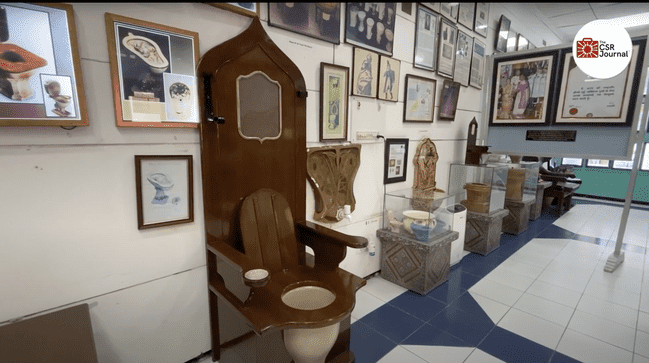The capital city alone has more than 30 museums, all of them quirky and interesting. Each year, all of these museums witness diverse categories of tourists, from school trips to international tourists interested in the culture of India, from couples spending time inside the quiet museum to families spending their weekend there. From the International Doll Museum to the Railway Museum, from memorials of national leaders to the interesting National Museum for History, Delhi is nothing less than a paradise when it comes to museums and art galleries.
One such museum is the Sulabh International Museum of Toilets. Situated in West Delhi, this museum represents the centuries-old sanitary habits of human civilisation.
About the Museum
The International Museum of Toilets was established in 1992 by Dr. Bindeshwar Pathak. Pathak is a social activist who founded Sulabh, a sanitation and social reform movement, and an NGO called Sulabh International with the objective of spreading awareness about sanitation and manual scavengers.
Situated in South West Delhi, the museum houses various artefacts and pictures depicting the ways in which humans defecate. From the ancient Mohenjo-Daro and Harappa style drainage system of India to the modern Japanese toilet, the museum has it all.
Exhibits from more than 50 countries are housed inside a big hall, which is chronologically arranged into ancient, medieval, and modern. These exhibits bring out the development of toilets throughout the history of human civilisation, along with changes in social taboos, etiquette, sanitary habits, and the legal framework around toilets. Items on display include privies, chambers, Victorian toilet seat furniture, bidets, and water closets from as early as 1140 BC to the present time. Complementing the exhibits are the portraits depicting photographs of ancient community baths and private toilets inside the houses of ancient families.
There were also cartoons around defecation—some had Jennifer Lopez while others had Superman. There were other interesting artefacts as well, like the replica of the throne of King Louis XVI. It is known that the king had constipation and therefore spent a lot of time on the commode. So he decided to develop a commode inside his throne, sitting on which he would address his subjects in his court!
History of Toilets
Other artefacts depicted toilet pots that either converted poop into dry solid, ash, or manure, while other toilet seats had beautiful designs and embroidery. The toilets depicted the latest technology, like the one fitted in spacecraft being launched into outer space. One such technology was from Russia, purchased by NASA, that converts urine into potable water. This technology costs $19 million.
In 1596, Sir John Harrington designed flush pots during the reign of Queen Elizabeth. During this time, this innovation was not accepted or used by many, but in the time to come, this very innovation changed the way people went to the loo forever.
A museum is a peaceful place where one connects not only with history but also with the society around. The presence of a museum inside the city is very important for the intellectual development of the entire area. It not only adds a unique marker to the cityscape but also provides much-needed information on any topic in the most amusing manner.
It is because of this that Time magazine called the International Museum of Toilets one of the 10 weirdest museums.
What People Say
“Dr. Pathak started this museum just to give an immensely impactful and attractive look to sanitation, health, and hygiene, so that people have a good perception about this. He never wanted to advertise; he just wanted a word-of-mouth advertisement—slow, but effective. Whosoever visits this campus gathers information, and when they talk about the museum to other people, even others get curious to know what the toilet museum is. With the same curiosity, they come back with more people,” said Narjid, the chief creator of the museum.
“I decided to come here because it was unique. I’m not that interested in museums actually, but I thought this place could offer something interesting. My main purpose of travel to India is to see unique things, and so I thought this place was something,” said Cha Joo, a resident of LA, who has visited India to travel. For him, visiting this museum became a must-visit in Delhi.
Long or Short, get news the way you like. No ads. No redirections. Download Newspin and Stay Alert, The CSR Journal Mobile app, for fast, crisp, clean updates!
App Store – https://apps.apple.com/in/app/newspin/id6746449540
Google Play Store – https://play.google.com/store/apps/details?id=com.inventifweb.newspin&pcampaignid=web_share


